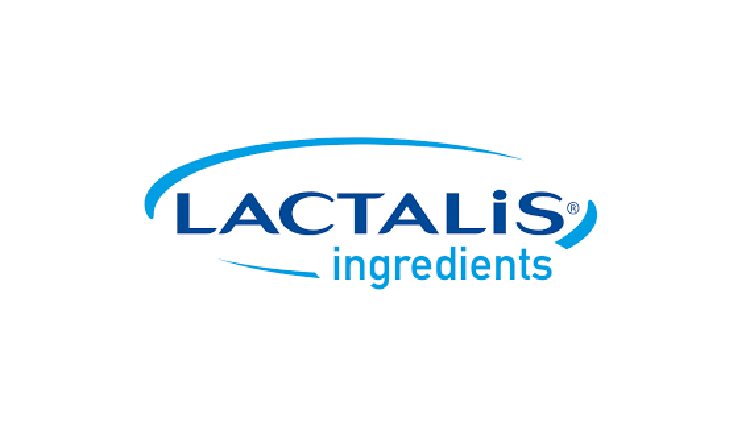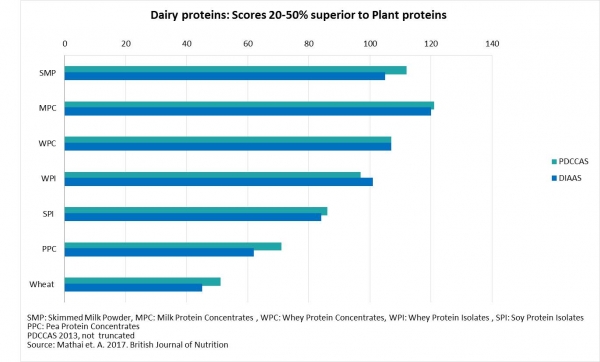Promotional Features
Dairy proteins: complete proteins for versatile nutritious and tasty applications
Consumers driving the growth of the global protein ingredients market
Driven by consumers’ beliefs and increasing awareness of the health benefits associated with protein consumption, the global protein ingredients market is expected to reach $48.77 billion by 2025, growing at a CAGR of over 7% from 2016 to 2025.[1]. Animal protein ingredients emerged as the largest segment, accounting for 72.3% of the global market in 2016 in terms of revenue. This predominance may be partially credited to the strong scientific evidence supporting the health benefits of these products, and more specifically the extensive amount of research backing the use of dairy proteins, including for highly-sensitive applications such as baby food and clinical nutrition.
Modern consumers are more and more educated and increasingly conscious of the direct link between their diet and their overall wellbeing, which inspires them to seek out the best possible nutrition to support their wellness goals and lifestyle choices. Therefore, consumers now tend to value quality over quantity and are embracing more balanced diets, favoring eating patterns that supply the appropriate nutrients in the right quantities rather than being very high in one specific nutrient.
Protein quality over protein quantity
Present throughout the body, protein consists of one or more chains of smaller molecules called amino acids. Being involved in countless bodily functions such as our metabolism, growth, skin regeneration, satiety, athletic performance and recovery as well as curbing age-related loss of muscle mass known as sarcopenia, etc.; it plays an essential part in the body’s structure, function and regulation of tissues and organs.
Because some of the amino acids needed cannot be synthesized by the human body, daily consumption of high-quality protein is vital to ensure a consistent supply of those essential amino acids (EAAs). In this regard, not all protein sources are created equal and they vary greatly in the amount and type of amino acids they contain. For example, most plant-based proteins lack one or more EAAs, which means that a combination of several protein sources is needed to achieve adequate nutrition and compare to single-source complete proteins such as whey and milk proteins.
No matter what your circumstances are (age, pregnancy, weight management, sports training, active lifestyle, etc.), every human needs a balanced diet providing high-quality proteins. A high-quality protein can be defined as a protein that contains all the essential amino acids in quantities required to maintain optimal health and avoid deficiencies, while offering excellent bioavailability and rapid digestibility.
As protein consumption continues to expand among a wider range of consumers, most people are now aware of the integral role this key nutrient plays in the human body. However, their awareness of protein quality disparities remains relatively low and their purchases tend to be influenced by their own perceptions about health and lifestyles rather than hard facts and figures.
Dairy, a reliable source of protein with a proven track record
Not only are dairy proteins complete proteins containing all essential amino acids, but they also have the highest levels of essential amino acids on total protein compared to all other sources. As shown in the figure below, dairy proteins such as whey and casein have the highest protein quality scores both using the Protein Digestibility Corrected Amino Acid Score (PDCAAS) and Digestible Indispensable Amino Acid Score (DIAAS) methods.
The proteins found in milk, casein and whey protein, are both excellent sources of all amino acids that differ in structure and digestion speed. Casein is a slow-digesting protein rich in micellar calcium. Consumption results in a steady release of amino acids over a period of several hours. Whey protein is easily and quickly digested, which makes its amino acids swiftly available for the body to use, stimulating a quick rise in muscle protein synthesis.
Whey to optimal nutrition
Thanks to a high concentration in EAAs and branched chained amino acids (BCAAs), as well as having the highest leucine content of all protein sources, whey protein contributes to metabolism, blood glucose homeostasis, neural function and fighting oxidative stress; thus it is a great option for numerous applications such as infant formulas, sports products, elderly and clinical nutrition solutions and more.
One of the main goals of whey protein consumption is to build and maintain muscle mass; which is not only critical to sports performance and recovery but also key to healthy weight management and to the prevention of the loss of muscle mass induced by aging. Whey protein is often used in infant nutrition as well, as it provides the highest quality amino acids for babies. It is also the protein that best mimics the casein to whey ratio of breast milk, making it a good choice for infant formulas. Being a rich source of bioactive peptides, whey protein offers a wealth of additional benefits.
Due to its unique composition and rapid digestibility, whey protein is an asset in developing high-quality products that fulfill consumers’ ever more demanding requirements.
Staying true to their roots and honoring nature’s bounty
Despite all the perks of dairy proteins, the landscape is changing and consumer interest in plant-based alternatives is fueling a diversification of protein sources. This trend mainly stems from evolving consumer perceptions that these alternatives are healthier, more sustainable and better for the planet than traditional animal sources. However, there are some misconceptions about dairy proteins’ sustainability and if we take a closer look, for example, the carbon footprint per gram of protein is greater for almond milk and soy milk than it is for cow’s milk[2]. Other evidence suggests that the process to produce plant-based protein such as pea protein is extremely complex, from extracting the protein to improving functionality and removing off-flavors; all of which is unnecessary with milk proteins which are naturally highly functional and good tasting.
Over the past few years, leading dairy groups have been making huge strides in sustainability, transparency, animal welfare and more, with the implementation of new corporate social responsibility policies and measures designed to offset their carbon footprint as well as to highlight the true value of dairy.
Who is Lactalis Ingredients?
Being part of Lactalis Group, one of the largest dairy companies in the world and leading cheese producer, Lactalis Ingredients benefits from a complete overview of operations, from the raw milk and processing to packaging. This control, combined with the very high standards and strict policies associated with its milk supply, allows Lactalis Ingredients to produce the highest quality products possible. Indeed, Lactalis Ingredients makes sure that the wholesomeness of the milk is preserved every step from field to consumer, ensuring that no nasties such as antibiotics and hormones are used.
Leveraging 80-plus years of dairy knowledge as well as 15-plus years of expertise in infant nutrition and baby food, Lactalis Ingredients aims to offer innovative solutions designed to fulfill the unique needs of manufacturers in the food and nutrition industry. The company is active in more than 100 countries and provides a complete range of high-quality dairy ingredients, including highly nutritious specialty proteins that meet the specific requirements of the infant, sports and clinical nutrition markets.
Prolacta and Pronativ, premium quality proteins for nutritional and tasty applications
Specialty proteins Prolacta and Pronativ are truly premium offerings designed to support consumers, regardless of age or health condition. Obtained directly from fresh milk through a gentle, low-temperature process, these proteins offer a consistent mineral profile, high digestibility as well as superior nutritional qualities compared to a traditional whey protein isolate and whey protein concentrate. In addition, the milk used is ethically sourced from farms close to the processing plant in order to avoid long transportation, excessive cooling units or the use of preservatives. France’s mild weather also provides the best conditions for cows to enjoy green pasture year-round for the highest quality milk.
To best support babies’ growth and development when breastfeeding is not possible, Lactalis Ingredients developed Prolacta, a range of soluble milk proteins dedicated to infant formula and baby food. Prolacta offers an excellent biological value and a balanced amino acid profile with high levels of EAAs, allowing formulators to mimic breast milk as closely as possible. Moreover, the particularly high tryptophan levels in Prolacta support the reduction of the overall protein content in baby formulas while maintaining optimal levels of nutrients; thus contributing to the healthy growth of the baby and reducing the risk of obesity later in life. Prolacta also contains bioactive peptides such as alpha-lactalbumin, immunoglobulins and lactoferrin that studies have shown may protect infants from intestinal infections and gastrointestinal discomfort.
Pronativ’s qualitative amino acid profile and preserved protein fractions make it an asset for the formulation of sports, diet and clinical nutrition products. Benefits on athletic performance and sarcopenia have been uncovered through extensive research conducted over the past 10 years and published in reputable scientific journals. Beyond these nutritional properties, the native whey protein Pronativ is adapted to the formulation of clear water-based beverages up to 7% protein. Thanks to its very clean taste, with no protein aftertaste, and versatility it is the ideal ingredient to boost innovation and explore new applications.
Innovate with dairy
Besides specialty proteins Prolacta and Pronativ, the company also offers high-quality whey and milk proteins, acid casein as well as Laktein, a range of heat stable whey protein concentrates and isolates perfectly adapted to sports and clinical nutrition thanks to their high microbiological quality.
Offering a very broad range of dairy proteins, Lactalis Ingredients can help customers find the right product depending on what they are looking for, whether it be a cost-effective option, a premium ingredient for high-end finished products, a specific flavor profile or unique functionalities.
[1] Gran View Research, Inc., 2018. Protein Ingredients Market Worth $48.77 Billion By 2025 | CAGR: 7.4%. Press Release viewed online at https://www.grandviewresearch.com/press-release/global-protein-ingredients-market-analysis[2] Susantha Jayasundara, 2017. Compiled data using the following sources:- Clune, S. et al. (2017) Systematic review of greenhouse gas emissions for different fresh food categories. Journal of - Cleaner Production. 140: 766-783https://www.healthline.com/health/milkhttp:/www.healthline.com/health/milk


